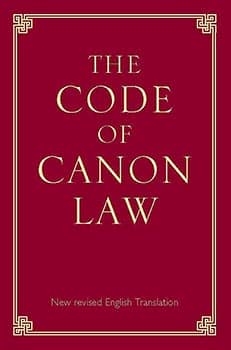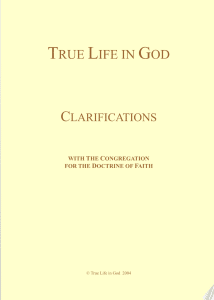Dear Friends in Christ,
On account of the immense good wrought by the TLIG divine messages that have yielded numerous conversions, led scores of individuals back to the Sacraments and strengthened unity among Christians, Satan has become enraged. This rage is manifest in his effort to sow confusion and division among the members of the household of faith.
In recent weeks, certain individuals, bereft of legitimate authority, have taken it upon themselves to discourage others from reading or sharing the TLIG messages that bear the Church’s present-day seals of the approval – an attitude prohibited by the Church and its Code of Canon law. By virtue of my vocation of theologian, and as articulated in Donum Veritatis, it is my duty to share with you the following points1.
 First, the Magisterium of the Church has the duty to “preserve God’s people from deviations and defections, and to guarantee them the objective possibility of professing the true faith without error” 2, as well as “expound it faithfully” 3, it examines publications, particularly works on faith and morals and pronounce whether they are free from doctrinal error.
First, the Magisterium of the Church has the duty to “preserve God’s people from deviations and defections, and to guarantee them the objective possibility of professing the true faith without error” 2, as well as “expound it faithfully” 3, it examines publications, particularly works on faith and morals and pronounce whether they are free from doctrinal error.
On March 19, 1975, the Congregation for the Doctrine of the Faith issued norms for pastors of the Church who have the duty to be vigilant with publication of materials on faith and morals, which should be submitted to the Church for “approval.” This mandate was reiterated in the 1983 Code of Canon Law, canon 823. This approval occurs through a process that begins with the author submitting the manuscript to the censor librorum or deputatus, who is appointed by the bishop or other ecclesiastical authority to make such examinations. If the censor finds no doctrinal error in the work, he grants a Nihil Obstat (“Nothing obstructs” its publication) attesting to this. If the bishop grants his Imprimatur (“Let it be printed)”, this ecclesiastical seal constitutes an ‘approval’ of the work that allows it to be “displayed and sold in churches” 4 of all dioceses of the Catholic Church and a declaration of “both a juridical and a moral guarantee for the authors, the publishers and the readers” 5 that the work “contains nothing contrary to the Church’s authentic magisterium on faith or morals” and “that all the pertinent prescriptions of canon law have been fulfilled.” 6 These seals were appended to the True Life in God writings.
 On November 24, 2005 Bishop Felix Toppo penned the following letter that accompanied the Magisterial Nihil Obstat (granted in 2005 and in 2021) underscoring the supernatural nature of the TLIG revelations:
On November 24, 2005 Bishop Felix Toppo penned the following letter that accompanied the Magisterial Nihil Obstat (granted in 2005 and in 2021) underscoring the supernatural nature of the TLIG revelations:
“I have read all the TRUE LIFE IN GOD books and meditated on their contents. I truly believe that the books contain the Divine Dialogue of the Holy Trinity, Our Lady and the Angels with humankind through Vassula Rydén. I have not found anything objectionable and anything contrary to the Church’s authentic authority on faith and morals. Reading these books and meditating on the contents are spiritually beneficial to all. I recommend these books to every Christian.”
 On September 30, 2004 Archbishop of Lipa Ramon C. Arguelles, STL, DD wrote the following letter further attesting to the supernatural nature of the TLIG prophetic revelations7:
On September 30, 2004 Archbishop of Lipa Ramon C. Arguelles, STL, DD wrote the following letter further attesting to the supernatural nature of the TLIG prophetic revelations7:
“Cardinal Joseph Ratzinger showed such Christ-like open-mindedness when he spearheaded the review of Mrs. Vassula Ryden’s case. Through Fr. Prospero Grech, Consultant of the Congregation of the Doctrine of the Faith, the good Cardinal asked Vassula to respond to five questions (see letter dated April 4th, 2002) to clarify some difficulties suggested in the Notification of 1995, regarding the writings of True Life in God, and about her activities related thereto. The responses will immensely help some doubting Thomases, who are entitled nevertheless to peace of mind…
 Cardinal Ratzinger asked P. Joseph Augustine Di Noia, O.P., Undersecretary of the Congregation of the Doctrine of the Faith, to provide Mrs. Rydén with a copy of that same letter to enable her to inform everyone about the exchange of clarification letters. I am extremely happy that Cardinal Ratzinger perfectly mirrors the attitude of the Holy Father whose great obsession and probably the reason for the life and energy he manifests is the UNITY OF CHRISTIANITY…
Cardinal Ratzinger asked P. Joseph Augustine Di Noia, O.P., Undersecretary of the Congregation of the Doctrine of the Faith, to provide Mrs. Rydén with a copy of that same letter to enable her to inform everyone about the exchange of clarification letters. I am extremely happy that Cardinal Ratzinger perfectly mirrors the attitude of the Holy Father whose great obsession and probably the reason for the life and energy he manifests is the UNITY OF CHRISTIANITY…
No matter what Mrs. Ryden’s past life may be, she can and already is an instrument of God in our days to bring to reality God’s dream, the Holy Father’s dream, the Church’s dream which may be the greatest event of the early years of the Third Millennium: THE UNITY OF ALL DISCIPLES OF CHRIST! People like Vassula who suffer for Christian unity with the Holy Father need encouragement, understanding and prayer. I am willing to give her that if only to join the Holy Father, Cardinal Ratzinger and many unknown souls who sincerely desire a renewal of Christianity, a renewed thrust of Evangelization, and unity of all Christian brethren. May Mary help us grow in the TRUE LIFE IN GOD.”8
I here wish to emphasize that it is canonically amiss for any prelate or layperson to challenge the authority and judgment of Catholic Archbishops re. their appended seals of approval. No prelate or layperson has the authority to supersede the Church Church’s Code of Canon Law that allows the episcopally approved TLIG writings to be displayed in churches, nor can any priest or layperson compel any of the Christian faithful to desist from sharing said approved writings.
Second, the Church requires of the Christian faithful “adherence with religious assent” 9 to the Church’s Magisterium, which is particularly exercised by those bishops teaching in communion with the Pope.
Third, bishops in communion with the Pope and exercising the Magisterium10 have granted to the TLIG prophetic revelations said seals of approval in 2005 and 2021, which remain in full force today.
 Fourth, by virtue of the conferral of the Magisterium’s Imprimatur and Nihil Obstat upon the TLIG prophetic revelations, Christians are prohibited from setting themselves up as their judge and from publicly condemning them11. On the contrary, inasmuch as all Christians are to “concur with their bishop’s judgment concerning faith and morals” and “adhere to this” judgment and to the Magisterium “with a religious assent of the mind” 12, the Magisterium’s seals of approval conferred upon TLIG writings elicit from the Christian faithful said religious assent.
Fourth, by virtue of the conferral of the Magisterium’s Imprimatur and Nihil Obstat upon the TLIG prophetic revelations, Christians are prohibited from setting themselves up as their judge and from publicly condemning them11. On the contrary, inasmuch as all Christians are to “concur with their bishop’s judgment concerning faith and morals” and “adhere to this” judgment and to the Magisterium “with a religious assent of the mind” 12, the Magisterium’s seals of approval conferred upon TLIG writings elicit from the Christian faithful said religious assent.
Fifth, noteworthy is Jordan Aumann and Raymond Cardinal Burke’s endorsement of the teaching that it is “reprehensible” for one to oppose publicly a work that bears the Church’s official seals of the approval13.
Sixth, regarding the 1995 Notification that was issued 28 years ago, this is to be read in light of the 2001-2004 official “Dialogue” that took place between the Congregation for the Doctrine of Faith (CDF) and Vassula Rydén, which yielded positive results. After this Dialogue Joseph Cardinal Ratzinger, Prefect of the CDF, stated in no uncertain terms that to the 26 year-old Notification “there have been modifications in the sense that we have written to the interested bishops that one should now read the Notification in the context of your preface and with the new comments that you have made” (cf. article of Professor Niels Christian Hvidt: Introduction to the dialogue between Vassula Rydén and the CDF). Cardinal Ratzinger granted Vassula permission to “publish” said “clarifications” and “the latest volume of ‘True Life in God,’” and he shared them with the Presidents of the Bishops’ Conferences of the five countries that had expressed an interest in the TLIG writings. And after this statement of the good cardinal, no less than four ecclesial seals of “approbation” were appended to the TLIG writings, which remain in full force today.
Seventh, the Church’s Notifications are not something new. Indeed, the CDF has alerted the faithful numerous times through the issuance of a public warning (in the form of Decrees and Notifications) against the writings of St. Faustina Kowalska, Blessed Antonio Rosmini, the Servant of God Luisa Piccarreta and other Church exemplars, which, in turn, elicited a dialogue and clarifications that led to their approval and publication.
 Indeed in a 1999 published interview (before the 2001-2004 official “Dialogue” that opened the Church’s doors for the subsequent publication and approval of the TLIG messages) with Joseph Cardinal Ratzinger, Professor Niels C. Hvidt asked the cardinal: “This last question… regards a contemporary prophetic figure – the Greek Orthodox Vassula Rydén. She is considered by many faithful, and by many theologians, priests and bishops of the Catholic Church to be a messenger of Christ. Her messages, which have been translated into 34 languages since 1991… The 1995 Notification on the obscure points as well as the positive aspects of her writings was interpreted by some commentators as a condemnation. Is that the case?” Joseph Cardinal Ratzinger replies, “…No, the Notification is a warning, not a condemnation. From the strictly procedural point of view, no person may be condemned without a trial and without being given the opportunity to air their views first” (The Problem of Christian Prophecy, in 30 Days Magazine, n. 1, 1999). Also cf. link: https://hvidt.com/hvidt.com/defaultd6f2.html?page=pub&CatHead=57&CatMain=58&IDF=34& sortset=default&pagenum=&show=text#en
Indeed in a 1999 published interview (before the 2001-2004 official “Dialogue” that opened the Church’s doors for the subsequent publication and approval of the TLIG messages) with Joseph Cardinal Ratzinger, Professor Niels C. Hvidt asked the cardinal: “This last question… regards a contemporary prophetic figure – the Greek Orthodox Vassula Rydén. She is considered by many faithful, and by many theologians, priests and bishops of the Catholic Church to be a messenger of Christ. Her messages, which have been translated into 34 languages since 1991… The 1995 Notification on the obscure points as well as the positive aspects of her writings was interpreted by some commentators as a condemnation. Is that the case?” Joseph Cardinal Ratzinger replies, “…No, the Notification is a warning, not a condemnation. From the strictly procedural point of view, no person may be condemned without a trial and without being given the opportunity to air their views first” (The Problem of Christian Prophecy, in 30 Days Magazine, n. 1, 1999). Also cf. link: https://hvidt.com/hvidt.com/defaultd6f2.html?page=pub&CatHead=57&CatMain=58&IDF=34& sortset=default&pagenum=&show=text#en
Nota bene: The CDF’s concern for the lack of clarity on the TLIG messages was also expressed in relation to many of the writings of St. Faustina Kowalska, Blessed Antonio Rosmini and the Servant of God Luisa Piccarreta – which, after a thorough examination, were granted the Catholic Church’s official Magisterial seals of the approval. Thus far history has taught us that when the Church issues a Notification and requests clarifications with respect to the writings of a particular individual, it has led to the conferral of her seals of approval. Such is the case with the TLIG writings, which were granted these seals.
Eighth, with respect to the 2007 Circular Letter, I noted in my recent publication, endorsed by two Catholic Bishops14, that said letter contains an inaccurate statement, which perplexingly asserts that the TLIG messages are the result of personal meditation (cf. chapter 1 of said publication). The individual who penned this letter does not appear to have been properly advised when he posted it. To rectify the matter, on August 5, 2017 and in a spirit of harmony, I submitted to (the now late) William Cardinal Levada a letter requesting a fraternal dialogue on this matter, but to this he did not reply. It is noteworthy that my addressing the matter is a duty the Church requests of her theologians: Cf. the CDF’s Instruction, Donum Veritatis, On the Ecclesial Vocation of the Theologian, arts. 20 and 30. The cardinal’s assertion drew its inaccurate information from a phrase that bears no reference source in the aforementioned 1995 Notification which, Cardinal Ratzinger affirmed, was later “modified.”
In sum, the True Life in God messages enjoy the Church’s official seals of approval that remain in full force today. These seals are backed by Canon law, which no prelate or layperson may alter or supersede. Therefore, if anyone should attempt to dissuade you or others from reading or sharing the TLIG messages, they are acting without legitimate authority. The Christian faithful possess the canonical right to read and meditate upon these messages, to grow from their lessons and to share them with others.
The more people meditate upon and grow from these messages, the more they assuage the sorrows of Jesus and of his Blessed Mother, sow peace and unity, and hasten the reign of God’s will on earth. In the TLIG prophetic revelations Jesus asks us to repent of our sins, cultivate love and humility, and pray for unity and to receive him worthily in his Body and Blood. He asks us to love the unlovable, and to forgive the unpardonable. It is fitting that we put his divine words into practice, whereby we may be considered the workers in his vineyard who have sown peace and helped realized his peace plan for these End Times.
May God bless you.
In Christ,
Rev. J.L. Iannuzzi, S.T.L., S.Th.D.
August 1, 2023



